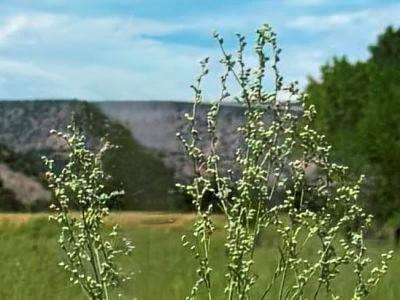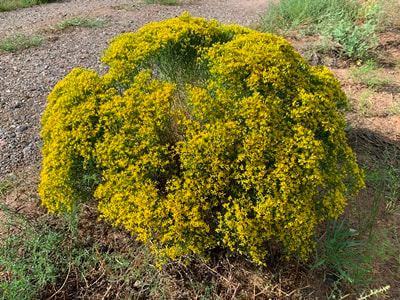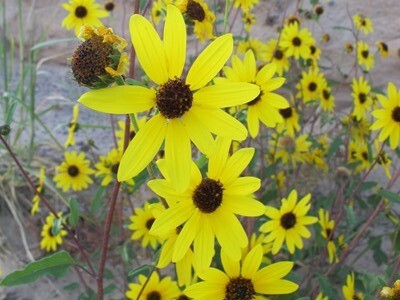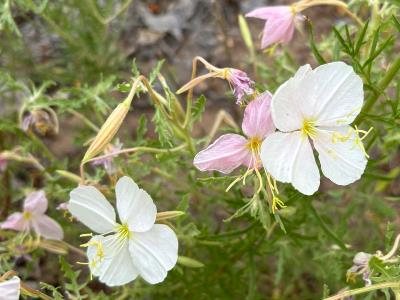|
The Bloom Blog Blooming this week in the environs of Abiquiú By Wildflowers of the Southern Rocky Mountains By Marilyn Phillips
Found in dry areas, woodlands, roadsides Seen blooming in August by Hwy 554 Several species of Globemallow grow in this area blooming from spring until fall. They have five orange petals forming a saucer-like flower. The foliage is covered with star-shaped hairs giving it a grey-green appearance. The shape of the leaves differentiates the species. Blooming now is Fendler’s Globemallow which grows to 4 feet tall with graceful stems; it can become shrub-like. Leaves are divided into three lobes, two smaller side lobes and a larger central lobe, all with scalloped edges. Flowers are over 1 inch across and produce a disc-shaped fruit with 11 to 15 segments, each segment contains a seed. Traditionally, Globemallow has been used to treat sand cricket bites; an infusion of the plant was taken for mouth sores, internal injury and hemorrhage, and it was also made into a lotion to treat external injuries. Source. If you are trying to identify a different flower then you can check what other flowers bloom this month. If you cannot identify a flower from the website, send a photo and where you took it to [email protected]. Read online for tips.
0 Comments
The Bloom Blog Blooming this week in the environs of Abiquiú By Wildflowers of the Southern Rocky Mountains for tips. Found in sandy areas, floodplains, saline or alkaline soils
Seen blooming in August near the Rio Chama Desert Goosefoot has no showy blooms and would disappear into the background but for its height and whitish appearance. It grows to about three feet high covered in a whitish powder. Members of the Goosefoot genus are so called because their leaves are shaped like a goose’s foot but the leaves of Desert Goosefoot are mostly narrow. Lower leaves may have the lobes that give them the goose foot shape but these usually wither as the plant matures. Flowers are tiny and greenish in dense clusters. Leaves and young shoots can be cooked and eaten like spinach. Seed can be ground into a powder and mixed with wheat or other cereals in making bread etc. Source. If you are trying to identify a different flower then you can check what other flowers bloom this month. If you cannot identify a flower from the website, send a photo and where you took it to [email protected]. Read online for tips. The Bloom Blog Blooming this week in the environs of Abiquiú By Wildflowers of the Southern Rocky Mountains Found at roadsides and in dry, open areas
Seen blooming in August off Hwy 554 Many yellow flowers bloom towards the end of summer. From a distance they may look similar but get closer and the size of the flowers, the leaves and growth habit will distinguish them. Snakeweed grows like a rounded bush from 12 to 30 inches high with thread-like leaves. This impressive plant is three feet across, probably thanks to all the rain it has received. The flowers are tiny with a few petals, less than 1/4" across, and grow in dense golden clusters. The shape, height and tiny flowers distinguish it. An abundance of Snakeweed is a sign of over-grazing because cattle dislike the taste. In the winter, Snakeweed dies back, leaving brittle stems that make great kindling. The stems were bound together to make brooms and the flowers used to make a dye. Snakeweed was used by Native Americans for a multitude of medicinal purposes, including as a treatment for snakebites, indigestion, bee stings, headaches, diarrhea, painful menstruation, colds, fevers and nosebleeds, and as a laxative for horses. Source. If you are trying to identify a different flower then you can check what other flowers bloom this month. If you cannot identify a flower from the website, send a photo and where you took it to [email protected]. Read online for tips. Prairie Sunflower, Plains Sunflower, Girasol,Helianthus petiolaris,Sunflower Family (Asteraceae)8/5/2024 The Bloom Blog Blooming this week in the environs of Abiquiú By Wildflowers of the Southern Rocky Mountains Found on hillsides, by roadsides, in sunny areas
Seen blooming in August near Hwy 554 Another of the sunflowers that seem to flourish in our area, the Prairie Sunflower grows to four feet tall with a hairy stem branching near the top. Leaves are bluish-green, rough in texture and usually lance-shaped, with stalks. The showy flower head is over two inches across and has 7 to 15 petals and a reddish-purple center. The bracts under the flower are lance-shaped and hairy. The Prairie Sunflower is very similar to the Common Sunflower but is much smaller and more slender. Traditionally the seeds were saved and eaten, and sometimes ground as meal. The Hopi used the plant as a spider bite medicine and the Navajo sprinkled a flower infusion on clothing for good luck in hunting. Dried flower petals were mixed with corn meal to make a ceremonial face powder for women. Source. If you trying to identify a different flower then you can check what other flowers bloom this month. If you cannot identify a flower from the website send a photo and where you took it to [email protected]. Read online for tips. The Bloom Blog Blooming this week in the environs of Abiquiú By Wildflowers of the Southern Rocky Mountains Found in sandy, disturbed soil, roadsides
Seen blooming in late July by Hwy 554 Patches of this bright white Evening Primrose have been blooming since June. It grows to about 18 inches high with many branches and pale stems. Flowers are over one inch across, with four heart-shaped petals, and are pleasantly fragrant. Like all evening primroses, the flowers open near sunset then wilt and turn pink in the heat of the sun the next morning. Traditionally, the plant was used as tobacco, the roots were used to make a poultice or lotion to treat swellings, sore throats, and muscle strains, the fruits and seeds were added to soup or made into gravy. Marriageable Hopi maids used flowers in their hair on holidays. The Zuni High Priest and the Sun Priest of the Corn Maidens gave the blossoms to young girls who chewed the blossoms, ejected the mass into their hands and rubbed it on their neck, breast, arms and hands to ensure that they would dance well so that it would rain and the corn would grow. Source. If you are trying to identify a different flower then you can check what other flowers bloom this month. If you cannot identify a flower from the website, send a photo and where you took it to [email protected]. Read online for tips. |
AuthorI am Marilyn Phillips, a native of England, whose love of nature and the outdoors from childhood brought me by a circuitous route to Crested Butte, Colorado in 1993 and 16 years later to northern New Mexico. My exploration of the many trails in these areas, my interest in wildflowers and photography, and career in computer system design came together in this creation. If you have any corrections, comments or questions, please contact me by email. Archives
September 2025
Categoriescopyright © 2020
|







 RSS Feed
RSS Feed